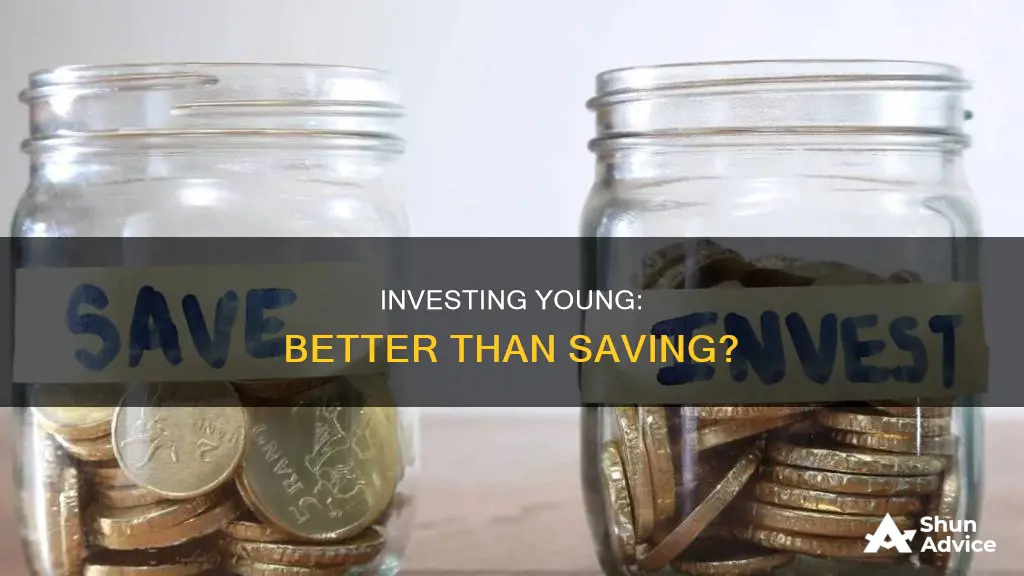
Investing and saving are both important concepts for building a sound financial future. While both can help you achieve a more comfortable financial future, it is crucial to understand their differences and when it is best to save or invest. The main difference between saving and investing is the level of risk taken. Saving typically yields lower returns but with almost no risk, while investing allows for higher returns but comes with the risk of loss.
Saving is generally considered safer than investing, as it carries little to no risk of losing money and is a good strategy for achieving short-term financial goals. On the other hand, investing offers the potential for higher returns over the long term but comes with the possibility of losing money.
Starting to invest early in your career or when you are young can have distinct advantages. One of the biggest advantages of investing young is the impact of compounding on your portfolio. Compounding occurs when you reinvest your earnings, and those earnings start working for you by generating more money. This allows you to invest less each month from an early age and still end up with a substantial amount during retirement.
Additionally, when you are young, you may have more risk tolerance and can afford to take on more risk in your investment portfolio. This is because you have more time to recover if things go wrong.
In conclusion, both saving and investing are essential components of a comprehensive financial plan. While saving provides a safety net and helps with short-term goals, investing offers the potential for higher long-term returns. However, it is important to remember that investing also comes with the risk of losing money. Therefore, finding the right balance between saving and investing is crucial to building wealth and achieving financial goals.
| Characteristics | Values |
|---|---|
| Time | The longer you have, the more time your money has to grow. |
| Risk | Younger investors can take more risks, as they have more time to recover from losses. |
| Returns | Investing can lead to higher returns than saving, but this is not guaranteed. |
| Interest | Compound interest can lead to greater wealth over time. |
| Inflation | Saving may not keep up with inflation, but investing can help you stay ahead. |
| Goals | Saving is better for short-term goals, while investing is better for long-term goals. |
| Accessibility | Savings are generally more accessible than investments. |
| Safety | Savings are safer than investments, as there is little to no risk of losing your money. |
What You'll Learn
- Compounding interest: Investing early maximises the benefits of compounding interest
- Risk tolerance: Younger investors can take on more risk, which can lead to higher returns
- Time in the market: Starting early means your money has more time to grow
- Building good habits: Investing when you're young helps establish good savings habits
- Tech-savviness: Younger investors can leverage their tech skills to make better investment decisions

Compounding interest: Investing early maximises the benefits of compounding interest
Compounding interest is a powerful tool for investors, allowing them to earn interest on interest. The earlier an individual starts investing, the more compounding interest can work in their favour. This is because the longer the duration of an investment, the more the compounding effect can take place, and the larger the returns will be.
Understanding compounding interest
Compounding interest is a process where interest is calculated on both the initial principal amount and any accumulated interest from previous periods. This means that an investor earns interest on their interest, resulting in exponential growth of their investment over time. The formula for calculating compound interest is:
> Compound interest = total amount of principal and interest in the future (or future value) minus principal amount at present (or present value)
> = [P (1 + i)n] – P
> = P [(1 + i)n – 1]
> Where:
> - i = annual interest rate
> - n = number of compounding periods
The higher the number of compounding periods, the larger the effect of compounding. For example, consider a 3-year loan of $10,000 at an interest rate of 5%, compounding annually. The amount of interest at the end of the loan would be $1,576.25.
The benefits of investing early
Investing early in one's career or during one's youth provides several benefits, including:
- Time advantage: The longer an individual invests, the more time their money has to grow. This results in greater compounding interest over time.
- Higher risk tolerance: Younger investors can afford to take more risks with their investments due to having more productive earning years ahead of them. This enables them to potentially achieve higher returns.
- Improved spending habits: Investing early encourages disciplined spending habits. It helps individuals prioritise contributing to their retirement plans or investments before spending on non-essential items.
- Experience: Starting to invest early provides a longer timeframe to study the market, refine investment strategies, and gain valuable experience that can lead to future investment success.
Example of compounding interest over time
To illustrate the power of compounding interest, consider the following example:
Ram starts investing INR 10,000 at an interest rate of 6.6%, compounded annually, from the age of 25. By the retirement age of 60, Ram accumulates a sum of more than INR 93,000. On the other hand, Ravi starts investing INR 15,000 at the same interest rate of 6.6%, but starts at the age of 35. By the age of 60, Ravi only accumulates around INR 74,000.
This example demonstrates how compounding interest can drastically affect investment outcomes. The key factor is the time the investment is allowed to grow, emphasising the importance of investing early to maximise the benefits of compounding interest.
Investing vs Saving: Understanding the Key Differences
You may want to see also

Risk tolerance: Younger investors can take on more risk, which can lead to higher returns
Risk tolerance is a crucial aspect of investing, and younger investors often have a higher risk tolerance than their older counterparts. This is primarily because younger investors have a longer time horizon, meaning they can endure market volatility and potential losses in the short term, with the expectation of higher returns over the long term.
Younger investors are generally in the early stages of their careers and have more time to recover from any potential investment losses. This longer time horizon allows them to take on more risk, which can lead to higher returns. For example, they can invest in riskier assets such as stocks, equity funds, and exchange-traded funds (ETFs), which offer the potential for higher returns but also carry a higher risk of loss.
Compounding interest also plays a significant role in the potential for higher returns. When you invest at a young age, your money has more time to grow and benefit from compounding interest. This means that even a small amount invested early on can accumulate substantial gains over time.
Additionally, younger investors may have more flexibility in their financial goals. They may be more willing to tolerate short-term losses as they have a longer time horizon for their investments to recover and grow. This higher risk tolerance can lead to investing in more volatile assets, which may result in higher returns over the long term.
It is important to note that while younger investors can generally tolerate more risk, it is still essential to assess their individual risk tolerance and financial situation. Factors such as investment goals, income, and net worth should also be considered when determining the appropriate level of risk for a younger investor.
In summary, younger investors often have a higher risk tolerance due to their longer time horizon, the potential for compounding interest, and the flexibility to endure short-term losses. This higher risk tolerance can lead to investing in riskier assets, resulting in the potential for higher returns over time. However, it is crucial to carefully assess an individual's risk tolerance and financial circumstances before making investment decisions.
Invest Your Savings Wisely: The Power of ETFs
You may want to see also

Time in the market: Starting early means your money has more time to grow
Time is one of the most powerful tools when it comes to investing. The earlier you start investing, the more time your money has to grow. This concept is often referred to as "time in the market".
Compounding, or reinvesting earnings, is often described as the "eighth wonder of the world" by Albert Einstein. The longer your investments have to compound, the more wealth they can generate. For example, a single $10,000 investment at age 20 would grow to over $70,000 by the time the investor was 60 years old (based on a 5% interest rate). Waiting until age 30, that same $10,000 would yield about $43,000 by age 60, and at age 40, it would yield only $26,000.
Additionally, starting early means you can take advantage of market growth over time. Historically, markets have grown over long periods, and the trajectory is generally upward. For example, the S&P 500 had an average rate of return of over 10%, adjusted for inflation, from 1980 to 2021.
Compounding is also beneficial for investments in the form of dividends and/or capital gains. The longer your money is invested, the more time it has to benefit from compounding interest. This can result in a significant difference in your investment value over time.
Starting to invest early also means you can take advantage of dollar-cost averaging. By investing a fixed amount at regular intervals, you purchase more shares when prices are low and fewer when prices are high. This helps to lower the average cost per share and can result in a larger return on your investment over time.
In summary, starting early gives your money more time to grow and compound, taking advantage of market growth and dollar-cost averaging. This can result in a significant difference in your investment value over time, making "time in the market" a crucial concept for investors.
Invest Your Savings Wisely: A Guide for Nigerians
You may want to see also

Building good habits: Investing when you're young helps establish good savings habits
Investing when you're young is a great way to establish good savings habits. It can be challenging to start saving for retirement, especially with high inflation rates, student loan debt, and the rising cost of living. However, starting early has several benefits and can make a significant difference in the long run. Here are some reasons why investing when you're young is a great way to build good savings habits:
Time is on your side
One of the most significant advantages young people have when it comes to investing is time. The power of compounding, often referred to as "the eighth wonder of the world" by Albert Einstein, allows your investments to grow exponentially over time. The earlier you start, the more time your money has to grow. For example, investing $2,000 a year from age 19 to 27 and then stopping can result in having $1 million by age 65. Waiting until age 27 to start saving would require saving for 38 years to reach a similar amount.
Higher risk tolerance
Young investors can afford to take on more risk due to their longer time horizon. This means they can invest in riskier assets with the potential for higher returns. If investments lose value, there is a higher chance of recovery over time. This also allows young investors to explore different investment options and learn from their successes and failures.
Tech-savvy skills
Younger generations tend to be more tech-savvy and can leverage their skills and knowledge of technology to their advantage when investing. They may be more comfortable using trading apps and online tools to research and make investment decisions. Additionally, investing in tech-driven companies can be a smart move if they continue to innovate and grow.
Building a solid financial future
Investing when you're young helps establish a solid financial foundation and can contribute to achieving long-term financial goals. It is crucial for saving for retirement, and it can also provide an income stream throughout your life. By starting early, you can benefit from the power of compounding and potentially accumulate more wealth over time.
In conclusion, investing when you're young is a great way to build good savings habits. It allows you to take advantage of time, higher risk tolerance, and tech-savvy skills to establish a solid financial future. By starting early and being consistent, you can put yourself on the path toward achieving your financial goals.
Investing in New York's 529: A College Savings Guide
You may want to see also

Tech-savviness: Younger investors can leverage their tech skills to make better investment decisions
Investing young has several advantages, and one of the most significant is the benefit of time. Compounding interest works in favour of those who start early, and historically, markets have grown over long periods. Younger investors can also leverage their tech-savviness to make better investment decisions.
Tech-savviness is a highly desirable skill for employers, as it boosts productivity and efficiency. It is a set of abilities that allow people to use technology in personal, educational, and professional settings. This includes the use of the internet and devices such as computers, smartphones, and tablets. Additionally, it involves understanding how technology works, troubleshooting, and staying updated with new trends in the market.
Younger investors can benefit from their tech skills in several ways:
- Data Analysis and Decision-Making: Tech-savvy individuals can utilise data analytics tools to gain insights into customer behaviour, market trends, and other vital indicators. This enables them to make more informed investment decisions.
- Access to Information: Social media platforms and online communities provide a wealth of information. Younger investors can stay updated on industry trends, connect with professionals, and discover new investment opportunities.
- Financial Technology: Fintech apps enable individuals to budget, invest, and track expenses effectively. Tech-savvy investors can make informed decisions, save for the future, and achieve their financial goals.
- Online Learning: Online platforms offer a range of educational resources, including coding skills, language learning, and personal finance management. Younger investors can leverage these resources to improve their financial literacy and make better investment choices.
- Remote Work and Flexibility: Cloud computing and remote collaboration tools allow tech-savvy individuals to work remotely and enjoy flexible work arrangements. This provides a better work-life balance, especially for those with family or personal commitments.
- Creative Skills: Creative and design roles benefit from tech-savviness as it allows individuals to explore new ideas and push boundaries. This creativity can be applied to developing engaging content, innovative marketing campaigns, and designing new products or services.
In conclusion, younger investors can harness their tech skills to enhance their investment journey. They can utilise data analytics, access online information, and take advantage of financial technology to make better-informed decisions. Additionally, online learning platforms can improve their financial knowledge, and remote work options can provide a healthier work-life balance.
Retirement Planning: 401(k)s, Investing, or Saving?
You may want to see also
Frequently asked questions
Investing when you're young gives your money more time to compound as you reinvest your earnings. You can take on more risk with your investments when you're young because you have more time to recover if things go wrong.
Investing always involves some level of risk, and there is no guarantee that you will make money or even get back what you've invested. It can be complex and requires discipline and a long-term perspective, which can be difficult for some people to maintain.
Saving is a great way to meet short-term financial goals and prepare for unexpected situations. Savings are generally low-risk, meaning your money is safe, and there are minimal fees involved.
Savings accounts offer low returns and may lose purchasing power over time due to inflation.







